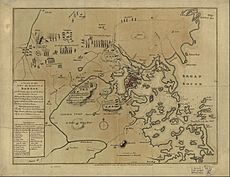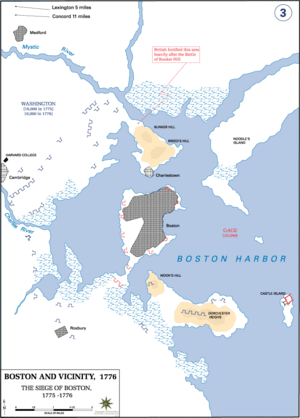Siege of Boston facts for kids
Quick facts for kids Siege of Boston |
|||||||
|---|---|---|---|---|---|---|---|
| Part of American Revolutionary War | |||||||
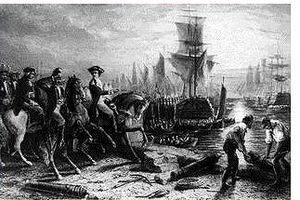 Engraving depicting the British evacuation of Boston |
|||||||
|
|||||||
| Belligerents | |||||||
| Commanders and leaders | |||||||
|
|
|
||||||
| Strength | |||||||
| 7,000–16,000 | 4,000–11,000 | ||||||
| Casualties and losses | |||||||
| Battle of Bunker Hill Over 400 killed or wounded, 30 captured Rest of siege 19 killed or wounded |
Bunker Hill 1,150 killed or wounded Rest of siege 60 killed or wounded, 35 captured |
||||||
The Siege of Boston was the very first part of the American Revolutionary War. It lasted from April 19, 1775, to March 17, 1776. During this time, American fighters from New England surrounded the city of Boston, where the British Army was stationed.
Both sides faced big problems getting enough food, supplies, and soldiers. The British could only get supplies by sea, but American ships made this difficult. After almost a year, the British decided to leave Boston. They moved their soldiers and equipment to Nova Scotia, which is now part of Canada.
The siege started right after the Battles of Lexington and Concord on April 19, 1775. Massachusetts militias quickly blocked all land routes into Boston. Later, these militias became the Continental Army, and George Washington was chosen to lead them.
In June 1775, the British captured Bunker Hill and Breed's Hill. The Americans had been planning to put cannons there to shoot at Boston. The British won this battle, but they lost many soldiers. This victory wasn't enough to break the American hold on the land around Boston. After this, the Americans kept Boston surrounded. There weren't many big battles, mostly just small fights and sniper attacks.
The British struggled to get supplies because American forces were active on land and sea. This meant British soldiers often didn't have enough food, fuel, or other important items.
In November 1775, George Washington sent Henry Knox on a special mission. Knox had to bring heavy cannons from Fort Ticonderoga, which the Americans had recently captured. It was a very hard job, but Knox managed to bring the cannons to Boston by January 1776. By March, these cannons were set up on Dorchester Heights, a high area overlooking Boston Harbor. This new threat meant the British supply ships were in danger.
British commander William Howe realized his army was in a bad spot. On March 17, he pulled his forces out of Boston and sailed to Halifax, Nova Scotia.
Contents
Why the Siege Happened
Before 1775, the British government started making the American colonies pay new taxes. The colonists were very unhappy because they had no say in the British Parliament. This idea was called "No taxation without representation".
After events like the Boston Tea Party, Britain sent 4,000 soldiers to Boston. General Thomas Gage was in charge of these troops. His job was to control the angry people in Massachusetts. The British Parliament also tried to shut down the local government. But the colonists simply formed their own government, called the Provincial Congress. This group asked local militias to get ready and gather weapons. General Gage also closed Boston's port, which caused many people to lose their jobs and become even angrier.
On April 19, 1775, British soldiers marched to Concord to seize military supplies. But militias from nearby towns met them at the Battles of Lexington and Concord. At Concord, some British forces were defeated at the North Bridge. On their way back to Boston, the British faced constant attacks and lost many soldiers. After this, militias from all over New England rushed to Boston, ready to fight.
The Siege Begins
Right after the battles on April 19, the Massachusetts militia quickly surrounded Boston. They blocked land access to Boston and Charlestown. This left the British only with access to the sea through Boston Harbor.
More and more colonial soldiers arrived from New Hampshire, Rhode Island, and Connecticut. General Gage was surprised by how many rebels there were. He said they were much better fighters than he expected.
General Gage focused on making Boston's defenses stronger. He built strong lines of defense in Roxbury and fortified four hills inside Boston. He also decided to leave Charlestown, moving his tired soldiers into Boston. This left the high ground of Charlestown, like Bunker Hill, empty. The heights of Dorchester, which overlooked the harbor, were also left open.
At first, the British made it hard for people to leave or enter Boston. But soon, they made a deal allowing some movement, as long as no weapons were carried. Many Patriot residents left Boston. Meanwhile, many Loyalists, who supported the British, moved into the city. They felt safer there. Some Loyalists even joined the British army.
Since the harbor wasn't completely blocked, the British Navy could still bring supplies from places like Nova Scotia. The American forces couldn't stop these big ships easily. However, American privateers (armed ships owned by private citizens) attacked British supply ships. This caused food prices in Boston to rise quickly, and British soldiers soon faced shortages. The Americans usually knew what was happening in Boston because people escaped the city. But General Gage didn't have good information about the American forces.
Early Fights and Skirmishes
On May 3, the Massachusetts Provincial Congress told Benedict Arnold to gather troops. His goal was to capture Fort Ticonderoga in New York. This fort was known to have heavy weapons but few defenders. Arnold met Ethan Allen and his militia, who also wanted to take Ticonderoga. Together, they captured Fort Ticonderoga and Fort Crown Point. They also seized a large military ship on Lake Champlain. They got over 180 cannons and other supplies that the new Continental Army needed for the siege.
Boston needed fresh meat, and the horses needed hay. On May 21, General Gage sent soldiers to Grape Island in the harbor to get hay. When American soldiers on the mainland saw this, they called out the militia. The militia fired at the British. They also set fire to a barn on the island, destroying 80 tons of hay. The British only got 3 tons.
After the Grape Island incident, American forces worked to remove all livestock and supplies from the harbor islands. On May 27, in the Battle of Chelsea Creek, British Marines tried to stop them. The Americans fought back. During the fight, a British ship, the Diana, ran aground and was destroyed. The Americans managed to take its weapons.
To try and stop the rebellion, Gage offered to pardon anyone who would put down their weapons on June 12. But he would not pardon John Hancock and Samuel Adams. This offer didn't stop the rebellion; instead, it made the Patriots even angrier, and more people joined the fight.
The Battle of Breed's Hill

Throughout May, the British received more soldiers, reaching about 6,000 men. On May 25, three new generals arrived: William Howe, John Burgoyne, and Henry Clinton. General Gage started planning how to break out of Boston.
The British decided to fortify both Bunker Hill and Dorchester Heights. They planned to take Dorchester Heights on June 18. But on June 15, the American Committee of Safety found out about the British plans. In response, they told General Ward to fortify Bunker Hill and the Charlestown heights. Colonel William Prescott led 1,200 men to build defenses on Bunker Hill and Breed's Hill on the night of June 16.
On June 17, the Battle of Bunker Hill took place. British forces under General Howe captured the Charlestown peninsula. The British won the battle and took the high ground. However, they suffered huge losses, with about 1,000 men killed or wounded. This included 92 officers. Because of these heavy losses, the British didn't launch any more direct attacks on American forces. The Americans lost the battle, but they had successfully fought against the well-trained British soldiers. After this, the siege became a stalemate, meaning neither side could make a big move.
A Long Stand-Off
General George Washington arrived in Cambridge on July 2. He set up his headquarters at Harvard College. The next day, he officially took command of the new Continental Army. More soldiers and supplies were arriving, including skilled riflemen from Maryland and Virginia. Washington began to train the militias into a more organized army. He appointed officers and introduced stricter rules.
Washington made officers wear special clothes so people could tell their rank. On July 16, he moved his headquarters to the John Vassall House in Cambridge. This house later became famous as the home of Henry Wadsworth Longfellow. By the end of July, about 2,000 riflemen arrived. Their accurate rifles were new to New England, and they used them to bother the British soldiers in Boston.
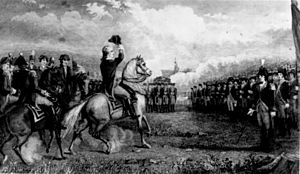
Washington also ordered improvements to the defenses. Trenches were dug and extended closer to Boston. However, these efforts didn't greatly affect the British occupation. There were occasional shots fired at the workers and guards. On July 30, the British attacked an American outpost and burned some houses in Roxbury. A few days later, on August 2, an American rifleman was killed. In revenge, other American riflemen attacked the British all day, killing or wounding many.
On August 30, the British made a surprise attack from Boston Neck, burned a tavern, and then went back to their defenses. That same night, 300 Americans attacked Lighthouse Island and burned the lighthouse. They killed several British soldiers and captured 23, losing only one American life. On another night in August, Washington sent 1,200 men to dig trenches on a hill near Charlestown Neck. Despite British cannon fire, the Americans successfully dug the trenches.
In early September, Washington started planning two things. First, he wanted to send 1,000 men from Boston to invade Quebec. Second, he wanted to attack Boston. Washington felt he could spare troops for Quebec because he heard from British deserters and spies that the British wouldn't attack Boston until they got more soldiers. On September 11, about 1,100 troops under Benedict Arnold left for Quebec.
Washington then suggested a full-scale attack on Boston by crossing the water in flat-bottomed boats. He worried his army would fall apart when winter came. But his officers disagreed and decided not to attack "for the present at least."
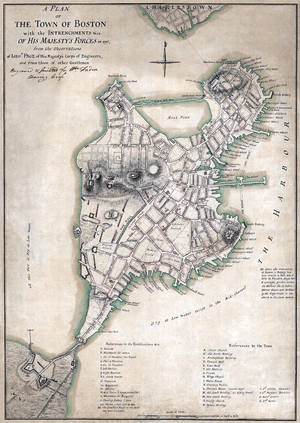
In early September, Washington also allowed local fishing boats to be used for spying and stopping British supplies. This was an early step towards the Continental Navy. The governments of Connecticut and Rhode Island also started arming ships and allowing privateering.
In early November, 400 British soldiers went to Lechmere's Point to get livestock. They took 10 cattle but lost two soldiers in a fight with colonial troops. On November 29, American Captain John Manley captured a very important British ship, the Nancy, just outside Boston Harbor. It was carrying a large amount of weapons and military supplies for the British troops in Boston.
As winter arrived, both sides faced problems. The Americans had so little gunpowder that some soldiers were given spears instead of guns. Many American soldiers were also unpaid, and their enlistments were ending soon. On the British side, General Howe, who had replaced Gage in October, faced different issues. Wood was so scarce that British soldiers had to cut down trees and tear down wooden buildings, including the Old North Meeting House.
Supplying Boston became harder due to winter storms and more American privateers. An American fleet of about 12 converted merchant ships captured 55 British ships that winter. Many of these captured ships were carrying food for the British. The British soldiers were so hungry that many wanted to desert. Worse, diseases like scurvy and smallpox broke out in the city. Washington's army also dealt with smallpox. He moved infected soldiers to a separate hospital to prevent the disease from spreading.
Washington wanted to attack Boston again in October, but his officers thought it was better to wait until the harbor froze. In February, when the water between Roxbury and Boston Common froze, Washington thought about attacking across the ice. But his officers again advised against it. Washington was worried his army would leave in the winter. He also knew how easily Howe could break his army's lines. He finally gave up on the ice attack and chose a safer plan: fortifying Dorchester Heights with the cannons from Fort Ticonderoga.
In mid-January, British Major General Henry Clinton and 1,500 men sailed for the Carolinas. Their goal was to join other British troops and capture a port in the southern colonies. In early February, a British raiding party crossed the ice and burned several farmhouses in Dorchester.
The End of the Siege
Between November 1775 and February 1776, Colonel Henry Knox and his team used sleds to move 60 tons of heavy cannons. These cannons had been captured at Fort Ticonderoga. It was a very difficult journey across frozen rivers, but they arrived back in Cambridge on January 24, 1776.
Fortifying Dorchester Heights
Some of these Ticonderoga cannons were bigger and had a longer range than any the Americans had before. They were placed in defenses around the city. On the night of March 2, 1776, the Americans started firing these cannons at Boston. The British fired back. This exchange of fire continued until March 4. It didn't cause much damage to either side, but it did damage houses and kill some British soldiers in Boston.
On March 5, Washington moved more Ticonderoga cannons and thousands of men overnight to Dorchester Heights. This high ground overlooked Boston. Since it was winter, the ground was frozen, making it hard to dig trenches. Rufus Putnam, a millwright, came up with a plan to build defenses using heavy timbers and bundles of wood called fascines. These were built secretly and brought in overnight. General Howe reportedly exclaimed, "My God, these fellows have done more work in one night than I could make my army do in three months." The British fleet and troops in Boston were now within range of the American cannons on Dorchester Heights.

The British immediately fired their cannons at the heights for two hours. But it had no effect because their guns couldn't reach the American cannons so high up. After this failure, Howe and his officers agreed they had to remove the Americans from the heights to keep Boston. They planned an attack, but a storm prevented it. So, the British decided to leave instead.
On March 8, some important people in Boston sent a letter to Washington. It said the British would not destroy the town if they were allowed to leave peacefully. Washington received the letter but formally rejected it because it wasn't addressed to him by name or title. However, the message worked: when the British left, the Americans didn't fire at them. On March 9, after seeing movement on Nook's Hill in Dorchester, the British fired a huge barrage all night. It killed four men with one cannonball, but that was all the damage done. The next day, the colonists collected 700 cannonballs that had been fired at them.
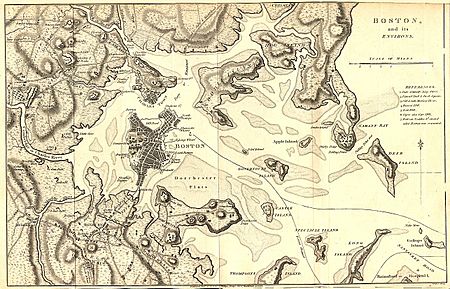
The British Leave Boston
On March 10, 1776, General Howe ordered everyone in Boston to give up all linen and woolen goods that could be used by the colonists for the war. A Loyalist named Crean Brush collected these goods, giving out worthless certificates in return. For the next week, the British fleet waited in Boston Harbor for good winds. Loyalists and British soldiers were loaded onto the ships. During this time, American ships outside the harbor successfully captured several British supply ships and took them to colonial ports.
On March 15, the wind became favorable, but then it changed direction. On March 17, the wind was favorable again. The British troops, who were allowed to burn the town if there was any trouble, started moving to their ships at 4:00 a.m. By 9:00 a.m., all the ships were sailing away. The fleet leaving Boston had 120 ships and more than 11,000 people. This included 9,906 British soldiers, 667 women, and 553 children.
What Happened Next
Americans Clean Up Boston

Once the British fleet sailed away, the Americans moved to take back Boston and Charlestown. At first, they thought the British were still on Bunker Hill, but it turned out the British had left fake soldiers there. Because of the risk of smallpox, only men who had already had the disease were allowed into Boston first, led by Artemas Ward. More of the American army entered on March 20, 1776, once it was safer.
Washington had agreed not to stop the British from leaving Boston. However, he didn't make their escape from the outer harbor easy. He told Captain Manley to bother the departing British fleet. Manley was successful, capturing ships, including the one carrying Crean Brush and his stolen goods.
General Howe left a few ships behind to stop any British vessels that might still be heading to Boston. These ships successfully redirected many British troop ships to Halifax. But some unsuspecting British troop ships still landed in Boston and were captured by the Americans.
The British leaving Boston marked the end of major fighting in the New England colonies. Washington, thinking the British would attack New York City next, left on April 4 with his army for Manhattan. This started the New York and New Jersey campaign.
What Happened to the British Generals
"If Sir William Howe had fortified the hills around Boston, he could not have been disgracefully driven from it," wrote his replacement, Sir Henry Clinton. General Howe was heavily criticized in Britain for his failures in Boston. However, he remained in command for two more years. General Gage never led another combat mission. General Burgoyne later fought in the Saratoga campaign, where he and 7,500 troops were captured. General Clinton commanded the British forces in America for four years (1778–1782).
What Happened to the Loyalists
Many Loyalists from Massachusetts left with the British when they evacuated Boston. Some went to England to start new lives. Others returned to America after the war. Many went to Canada, settling in places like Saint John, New Brunswick, and helped develop that area.
What Happened to Boston
After the siege, Boston was no longer a main military target. But it remained a key place for revolutionary activities. Its port was important for preparing warships and privateers. Boston's leaders played big roles in forming the future United States. Boston and other nearby towns celebrate March 17 as Evacuation Day.
Images for kids
-
Surrender of General Burgoyne at Saratoga, by John Trumbull
See also
 In Spanish: Asedio de Boston para niños
In Spanish: Asedio de Boston para niños


